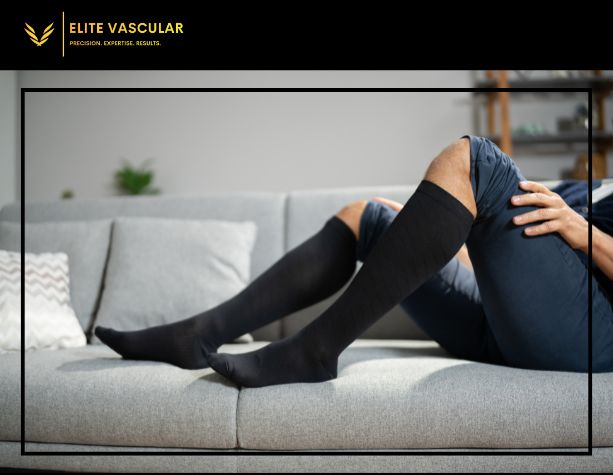Compression hose, also called compression stockings or socks, are necessary for many health problems and can help someone perform better in the game. Because they gently pressure on the legs and legs, these special clothes improve blood flow and reduce pain and inflammation at the same time. But if you want to make their maximum benefit, you’ll have to wear them correctly. That’s why this article shows you step by step how to wear it to make the maximum benefit of compression pants.
Understanding Compression Hose
What are Compression Hose?
Compression hose are stretching clothing that are for keeping your blood flowing normally as well as reducing pain and tightness in your legs. They come in different lengths, from knee height to thigh-length stockings or even from the entire length tights. They can be used to treat varicose veins, lymphedema and chronic venous inadequacy. Athletes wear them to boost their performance and reduce the time it takes to fix after exercise.
Types of Compression Hose
There are different types of compression hoses with each having been created for specific purposes while providing different amounts of pressure:
Graduated compression hose: These are strictly around the ankles and gradually loose the foot. They help blood flow by stopping clots in the veins, so they’re great to avoid sterilization.
Anti-embolism stockings: People who can’t roam in bed often wear them to avoid Deep Vein Thrombosis (DVT).
Non-Medical Support Hosiery: Such kinds offer uniform support throughout thus making them comfortable especially when one has been standing or sitting down for long hours.
Selecting the Right Compression Hose
Choosing the right compression level: Compression socks come in different levels of pressure measured in millimeters (MMHG) of mercury. Because of this, you should choose the level of pressure based on the saying of doctors which works best for you:
Lightweight (8-15 mmHg): This volume is enough to help with minor pain and swelling of the leg.
Moderate (15-20 mmHg): It can be used to deal with mild varicose veins, slight swelling as well as preventing fatigue.
Firm (20-30 mmHg): Usually recommended for moderate cases of varicose veins accompanied by considerable amounts of swelling which occur after surgeries have been done on them or during post-operative care period.
Extra Firm (30-40 mmHg): These are meant for severe forms of varicosities where there is massive edema due to chronic venous insufficiency.
Choosing the Right Size
Getting accurate measurements during sizing process plays a significant role towards ensuring that compression stockings fit correctly thus enhancing their effectiveness and comfort. Therefore, you need to measure around your ankle, calf & thigh areas while also noting down length from floor up to knee or thigh depending on type chosen.
Wearing Compression Hose Correctly
When Should I Wear Compression Hose?
It is advisable that one wears such garments throughout daytime when most active so as to derive maximum benefits from them. You should put them on immediately after waking up while still lying in bed since this is when legs are least swollen; take off just before sleeping unless otherwise instructed by doctor.
How Do I Put On Compression Hose?
Due to tightness involved when wearing these items, some people may find it difficult putting them on but following below steps will make application process easier:
Prepare Your Hose: Turn inside out up to heel part then fold into half or quarters depending upon preference.
Insert Your Foot: Place foot into foot portion carefully adjusting heel position until comfortable fit achieved
Tips for Easy Application
Wear rubber gloves: Rubber gloves will help you to hold the hose firmly and reduce the chances of damage the fabric.
Don’t use too much lotion: if you use lotion, use only a small amount and wait for it to dry completely before wearing your tights.
Caring for Your Compression Hose
Washing Your Hose
Taking good care of your compression stockings helps in extending their lifespan. Cleanse them daily to eliminate body oils and sweat that may weaken elastic fibers. It is advisable to hand wash using mild soap and cold water although some brands allow machine washing on gentle cycle.
Drying Your Hose
Avoid wringing out the support socks as this could spoil their elastic fibers; instead squeeze gently then lay flat until dry. Do not tumble-dry since heat can ruin their material.
Replacing Your Hose
Compression stockings lose their efficiency over time due to breakdown of elasticity thus should be replaced every three-six months depending on usage as well as care given.
Benefits of Wearing Compression Socks Properly
Better Blood Flow
Wearing compression socks correctly enhances blood circulation thereby preventing blood clots and lowering the risk of deep vein thrombosis (DVT). This also quickens healing among athletes through reducing muscle ache brought about by poor circulation.
Less Swelling & Painfulness
By applying constant pressure, compression garments ease swelling, pain & discomfort associated with varicose veins or lymphedema condition. They discourage fluid from gathering around legs hence decreasing puffiness too.
More Stamina During Exercise
Sportsmen wear these types of socks sometimes for better performance during events besides cutting down recovery period after training sessions. Compression fittings guarantee that there is increased supply of oxygen to muscles through improved flow rate which ultimately reduces fatigue levels.
In conclusion,
It is important to know how to wear compression socks for maximum benefits. Picking an appropriate type, size and pressure level; following right procedures in putting them on as well as caring plus maintaining can yield best outcome. Whether managing a medical problem or aiming at improving athletic abilities; these stockings will greatly contribute towards leg health comfort.
